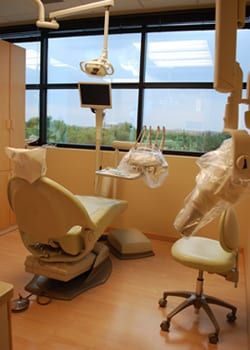Our Patient Services
We offer a range of endodontic treatments based on the individual needs of our patients. Most treatments fall into the following primary categories:

Range Of Treatments
• Root Canal Treatment:
“Endo” is the Greek word for “inside” and “odont” is Greek for “tooth.” Literally, endodontic treatment treats the inside tissue of the tooth. This tissue is called the “pulp.” When the pulp becomes sick by different irritants, such as decay or trauma, it can become sensitive to temperature, bite and sometimes even be accompanied by swelling. This is when your referring doctor will send you to an endodontist to determine the origin of the pain.
• Digital Radiography:
With proper care most teeth that have had root canal treatment can last as long as natural teeth. In some cases, a tooth that has received endodontic treatment can become diseased months or even years after successful treatment. If your tooth has failed to heal or has developed new problems, endodontic retreatment may be required. Causes for retreatment may include: placement of crown or final restoration was delayed; complicated anatomy went undetected in the first procedure; restoration did not prevent salivary contamination; new decay under the restoration. Your dentist and endodontist can determine the causes of failure and chances of success when treated.
• Endodontic Surgery (Apicoectomy):
In some cases endodontic (root canal) treatment alone cannot save the tooth. In some of these cases calcium deposits can make a canal calcified, and the tooth cannot be treated with our instruments to the end of the root. In such cases the endodontist may perform endodontic surgery to clean and seal the remainder of the canal. Surgery may also be used to treat damaged root surfaces or surrounding bone. It can also be an aid for diagnosis if there is suspicion of a fracture or a canal that could not be detected during conventional treatment. Surgery is typically done with local anesthetic in our office. Most patients are able to return to their normal activities the next day.
Other surgeries the endodontist might perform include dividing a tooth in half, repairing an injured root, or even removing one or more roots. The endodontist will be happy to discuss the specific type of surgery your tooth requires.
For patients who may require extra help to relax during endodontic procedures, we offer sedation dentistry. Sedation dentistry may include nitrous oxide, oral sedation and IV sedation options. Your endodontist can discuss with you your preferences, weigh them relative to your medical history and current situation, and give you the best advice that suits your individual needs. Our goal is to achieve successful endodontic treatment while providing you with the best overall dental health.
Our Mission
Las Colinas Endodontics is a specialty dental practice limited to endodontic (commonly known as root canal) therapy. Our office, located in Las Colinas, Texas, has highly trained and experienced Endodontists and a caring, professional staff that deliver quality, individual care to our patients.
Our modern, quality practice employs the latest technologies to diagnose and treat endodontic dental issues. All our operations are fully digitized, from the administrative patient record-keeping tasks at the front desk, to the dental operatories and the delivery of our treatments. Examples of our technology include:
Our State-of-the-Art Practice

• Microscopes and Imaging:
Magnification, fiber-optic illumination and high-resolution video are invaluable tools that assist the doctor in performing the technical aspects of endodontic treatment.
• Digital Radiography:
Advanced non-film dental imaging – known as Computed Dental Radiography (CDR) – reduces radiation levels by 80% compared to conventional x-ray film. Computerized radiographs taken by an electronic sensor allow the doctor and the patient to immediately review them on a computer screen, and can be archived, printed and sent electronically to your general dentist.
• Nickel-Titanium Instruments:
Instruments constructed of a unique alloy of nickel-titanium are used for cleaning and shaping of the root canal, along with hand and rotary instruments to help remove bacteria and tissue.
• Mineral Trioxide Aggregate (MTA):
MTA is a hydrophilic ceramic material used in our treatments. Its use as a biocompatible material with excellent resistance to leakage is widely supported by all endodontic literature.

• Ultrasonic Hand-Free:
These ultrasonic units are used to remove posts and metal instruments, as well as aid in the search for calcified canals. The diamond coated microscopic tips vibrate up to 25,000 cycles per second to insure accurate and speedy preparation of the tooth at the root-end when microsurgical intervention is indicated.
• Cone Beam Computed Tomography:
This allows 3D visualization of teeth, bone, sinuses and surrounding tissues. This enables us to better diagnose and treat complex cases.
Patient Education Corner – Frequently Asked Questions
The main purpose of a root canal (endodontic treatment) is saving your natural tooth. The alternative to a root canal is the extraction of a tooth. Nothing can truly replace what was biologically designed as a functioning natural tooth. Well over 22 million endodontic procedures are performed each year; nearly 15 million are root canals. The endodontic treatment removes the injured pulp (soft inner tissue) of your tooth and fills and seals the space.
If your tooth cannot be saved — and some cannot — you may consider replacements such as a bridge or dental implant. Your options may depend upon the condition of surrounding teeth and bone structure. Dental implant procedures can be complex, costly and they often require several visits and several months’ healing time before the procedure can be completed.
The cost associated with an endodontic treatment can vary depending on factors such as the severity of damage to the affected tooth and which tooth is affected. In general, endodontic treatment is much less expensive than tooth removal and replacement with an artificial tooth. Do everything possible to save your teeth before considering extraction. Nothing is as good as your natural tooth!
Many endodontic procedures are performed to relieve the pain of toothaches caused by pulp inflammation or infection. With modern techniques and anesthetics, most patients report that they are comfortable during the procedure. For the first few days after treatment, your tooth may feel sensitive, especially if there was pain or infection before the procedure. This discomfort can be relieved with over-the-counter or prescription medications. Follow your endodontist’s instructions carefully. If you have severe pain that lasts more than a few days, call your endodontist.
Your dentist or endodontist is suggesting endodontic surgery because he or she believes it is the best option for saving your own natural tooth. Of course, there are no guarantees with any surgical procedure. Your endodontist will discuss your chances for success so that you can make an informed decision.
When the outer hard tissues of the tooth are cracked, chewing can cause movement of the pieces and the pulp can become irritated. When biting pressure is released, the crack can close quickly resulting in a momentary, sharp pain. Irritation of the dental pulp can be repeated many times by chewing. Eventually the pulp will become damaged to the point that it can no longer heal itself. The tooth will not only hurt when chewing but may also become sensitive to temperature extremes. In time a cracked tooth may begin to hurt all by itself. Extensive cracks can lead to infection of the pulp tissue, which can spread to the bone and gum tissue surrounding the tooth.
Cracked teeth show a variety of symptoms, including erratic pain when chewing, possibly with release of biting pressure, or pain when your tooth is exposed to temperature extremes. In many cases, the pain may come and go, and your dentist may have difficulty locating which tooth is causing the discomfort
There are many different types of cracked teeth. The treatment and outcome for your tooth depends on the type, location, and extent of the crack.
Unlike a broken bone, the fracture in a cracked tooth will not heal. In spite of treatment, some cracks may continue to progress and separate, resulting in loss of the tooth. Placement of a crown on a cracked tooth provides maximum protection but does not guarantee success in all cases.
The treatment you receive for your cracked tooth is important because it will relieve pain and reduce the likelihood that the crack will worsen. Once treated, most cracked teeth continue to function and provide years of comfortable chewing. Talk to your endodontist about your particular diagnosis and treatment recommendations; (s)he will advise you on how to keep your natural teeth and achieve optimum dental health.
While cracked teeth are not completely preventable, you can take some steps to make your teeth less susceptible to cracks.
- Don’t chew on hard objects such as ice, un-popped popcorn kernels or pens.
- Don’t clench or grind your teeth.
- If you clench or grind your teeth while you sleep, talk to your dentist about getting a retainer or other mouth-guard to protect your teeth.
- Wear a mouth-guard or protective mask when playing contact sports.
Chipped teeth account for the majority of all dental injuries. Dislodged or knocked-out teeth are examples of less frequent but more severe injuries. Treatment depends on the type, location and severity of each injury. Any dental injury, even if apparently mild, requires examination by a dentist or an endodontist immediately. Sometimes neighboring teeth suffer an additional, unnoticed injury that will only be detected by a thorough dental exam.
Chipped primary (or “baby”) teeth can be esthetically restored. Dislodged primary teeth can, in rare cases, be repositioned. However, primary teeth that have been knocked out typically should not be replanted. This is because the replantation of a knocked-out primary tooth may cause further and permanent damage to the underlying permanent tooth that is growing inside the bone.
Children’s permanent teeth that are not fully developed at the time of the injury need special attention and careful follow up, but not all of them will need root canal treatment. In an immature permanent tooth, the blood supply to the tooth and the presence of stem cells in the region may enable your dentist or endodontist to stimulate continued root growth.
Endodontists have the knowledge and skill to treat incompletely formed roots in children so that, in some instances, the roots can continue to develop. Endodontists will do all that is possible to save the natural tooth. These specialists are the logical source of information and expertise for children who are victims of dental trauma.
The nature of the injury, the length of time from injury to treatment, how your tooth was cared for after the injury and your body’s response, all affect the long-term health of the tooth. Timely treatment is particularly important with dislodged or knocked-out teeth in order to prevent ‘root resorption’.
Resorption occurs when your body, through its own defense mechanisms, begins to reject your own tooth in response to the traumatic injury. Following the injury, you should return to your dentist or endodontist to have the tooth examined and/or treated at regular intervals for up to five years to ensure that root resorption is not occurring and that surrounding tissues continue to heal. It has to be noted that some types of resorption are untreatable.